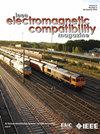Data-Driven Topology Design for Conductor Layout Problem of Electromagnetic Interference Filter
IF 2.5
3区 计算机科学
Q3 ENGINEERING, ELECTRICAL & ELECTRONIC
IEEE Transactions on Electromagnetic Compatibility
Pub Date : 2025-04-28
DOI:10.1109/TEMC.2025.3558260
引用次数: 0
Abstract
Electromagnetic interference (EMI) filters are used to reduce electromagnetic noise. It is well known that the performance of an EMI filter in reducing electromagnetic noise largely depends on its conductor layout. Therefore, if a conductor layout optimization method with a high degree of freedom is realized, then a drastic performance improvement is expected. Although there are a few design methods based on topology optimization for this purpose, these methods have some difficulties originating from topology optimization. In this article, we, therefore, propose a conductor layout design method for EMI filters on the basis of data-driven topology design (DDTD), which is a high degree of freedom structural design methodology incorporating a deep generative model and data-driven approach. DDTD was proposed to overcome the intrinsic difficulties of topology optimization, and we consider it suitable for the conductor layout design problem of EMI filters. One significant challenge in applying DDTD to the conductor layout design problem is maintaining the topology of the circuit diagram during the solution search. For this purpose, we propose a simple yet efficient constraint. We further provide numerical examples to confirm the usefulness of the proposed method.电磁干扰滤波器导体布局问题的数据驱动拓扑设计
电磁干扰滤波器用于降低电磁噪声。众所周知,EMI滤波器在降低电磁噪声方面的性能在很大程度上取决于其导体布局。因此,如果实现一种具有高自由度的导线布局优化方法,那么将有望大幅提高性能。虽然目前已有一些基于拓扑优化的设计方法,但这些方法都存在一些源于拓扑优化的困难。因此,在本文中,我们提出了一种基于数据驱动拓扑设计(DDTD)的EMI滤波器导体布局设计方法,这是一种结合深度生成模型和数据驱动方法的高自由度结构设计方法。DDTD是为了克服拓扑优化的固有困难而提出的,我们认为它适用于EMI滤波器的导体布局设计问题。将DDTD应用于导体布局设计问题的一个重大挑战是在求解过程中保持电路图的拓扑结构。为此,我们提出了一个简单而有效的约束。通过数值算例验证了所提方法的有效性。
本文章由计算机程序翻译,如有差异,请以英文原文为准。
求助全文
约1分钟内获得全文
求助全文
来源期刊
CiteScore
4.80
自引率
19.00%
发文量
235
审稿时长
2.3 months
期刊介绍:
IEEE Transactions on Electromagnetic Compatibility publishes original and significant contributions related to all disciplines of electromagnetic compatibility (EMC) and relevant methods to predict, assess and prevent electromagnetic interference (EMI) and increase device/product immunity. The scope of the publication includes, but is not limited to Electromagnetic Environments; Interference Control; EMC and EMI Modeling; High Power Electromagnetics; EMC Standards, Methods of EMC Measurements; Computational Electromagnetics and Signal and Power Integrity, as applied or directly related to Electromagnetic Compatibility problems; Transmission Lines; Electrostatic Discharge and Lightning Effects; EMC in Wireless and Optical Technologies; EMC in Printed Circuit Board and System Design.

 求助内容:
求助内容: 应助结果提醒方式:
应助结果提醒方式:


